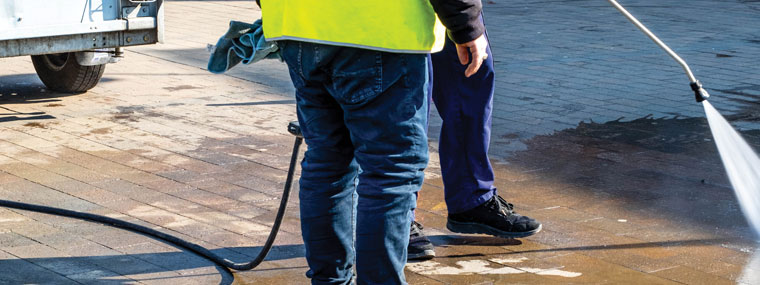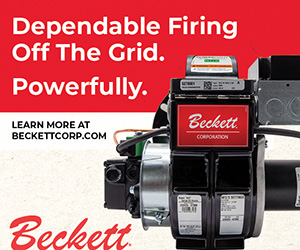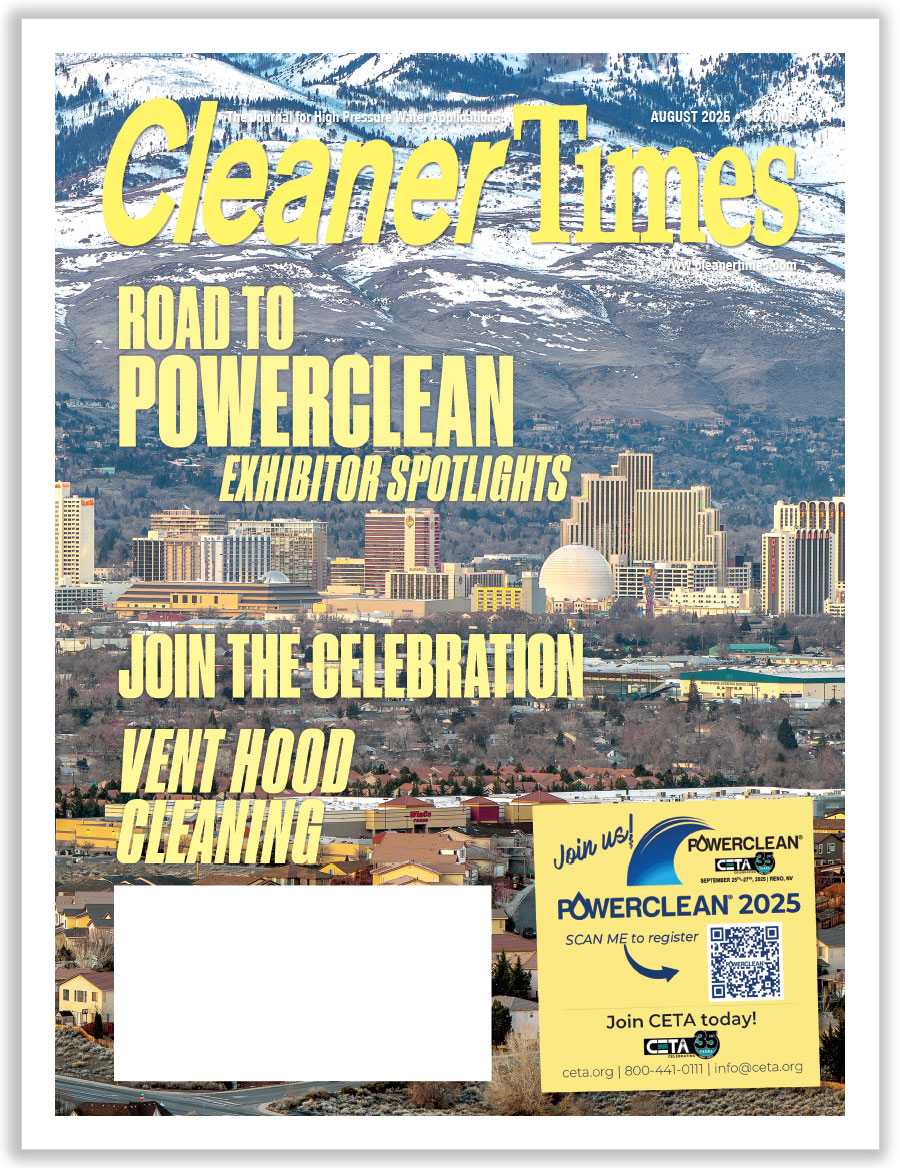
Power Washers’ Guidebook
Environmental Concerns, Part I
By Terri Perrin / Published November 2022
Main Contributor: Jimmy Welch, Vice President of Engineering, American Pressure Inc. Additional support: Ron W. Robarge, P.E., Director of Engineering, Spartan Manufacturing Corporation; and Aaron Auger, Water Treatment Division Manager, Mi-T-M Corporation

Author’s Note: There are several links to online resources to further support the information presented in this article. They are referenced in a bibliography at the end of the piece. While full links are provided, you may find it easier to simply type the descriptions in a Google search. A sidebar, with acronyms, is also provided for your convenience as acronyms are used throughout the article.
Wildfires. Floods. Catastrophic weather-related events. All of these natural disasters are believed to be a result of climate change, and the fingers of blame point directly at our day-to-day activities, both as individuals and business operators. While you may think that you as a large- (or small-) business operator in the power washing industry may have little environmental impact … think again! There is much to know (and do!) to ensure that our industry remains at the forefront of environmental awareness and shows ongoing leadership relating to our industry’s potential long-term impact on the earth.
This chapter provides an overview of environmental issues associated with power washing and a brief review of contractors’ responsibilities. It is imperative that contractors know the local, state, and federal regulations that apply to a job site before undertaking any work; and then, adhere to those regulations.
Water Resources Management and The EPA
Cities and counties across the USA are regulated under the National Pollutant Discharge Elimination System (NPDES) and the Environmental Protection Agency (EPA).1 These government bodies prohibit the discharge of pollutants and non-stormwater runoff into storm drain systems, which is referred to as the Municipal Separate Storm Sewer System or MS4. The EPA mandates that wastewater from mobile detailing, pressure/power washing, steam cleaning, carpet cleaning, or similar activities shall not be discharged to the MS4 unless authorized by an NPDES permit.2
The Clean Water Act (CWA)3,4 prohibits anyone from “discharging pollutants through a point source into a water of the United States” unless they have an NPDES permit. The permit will contain limits on what you can discharge, monitoring and reporting requirements, and other provisions to ensure that the discharge does not hurt water quality or people’s health.
While some people may think it is “new,” the California Air Resources Board5 (CARB) has also played a significant role in directing the future of environmental awareness and regulations for business and industry for decades. Many other states across the nation are either following suit or closely monitoring the regulatory changes in CA.
“As soon as the EPA was formed in the early 1970s, the power washing industry [as a whole] started taking note of air emissions and wastewater management,” explains Jimmy Welch, VP of Engineering, American Pressure Inc. “Be aware that the EPA and CARB make money through fines, so it was anticipated that they would be vigilant in watching for violations. While I understand the need for the regulations, there is often crossover from one industry to another, and regulations are ever-changing. Noisy, two-cycle gas-powered leaf blowers and four-cycle lawn mowers—both of which produce emissions [by burning fuel for power or heat through chemical reactions and from leaks from industrial processes or equipment]—have been on the radar for years.
“After receiving many complaints about them, CARB began passing regulations relating to air pollution due to small engine use overall,” adds Welch. “This also affected power washers. Engine manufacturers have been affected by this for many years and have had to modify exhaust and fuel systems. It keeps getting harder and harder to meet the requirements. ‘Evaporative testing,’ for example, now includes everything from a small engine’s fuel cap, tank, and lines to carburetors. The big political battle is electric against oil.”
In response to ever-increasing regulations, in 1990 the Cleaning Equipment Trade Association (CETA) formed a technical committee that examines everything—safety and emissions standards, water conservation, chemicals, soft wash, and more. Increasing regulations have forced our industry to look at both wastewater management and emission controls relating to the Clean Air Act.6 That’s why, Welch believes, our industry needs the support of CETA and Power Washers of North America (PWNA) members as well as buy-in from all service providers.
Power Washing Versus Pressure Washing
Before we delve into the most environmentally friendly ways to provide cleaning services using water under pressure, let’s first define the differences between “power washing” and “pressure washing.” Both terms are often used interchangeably, but the fact is they’re two different processes. Since our industry has had to evolve and become more cognizant of water use and its recovery and disposal, methods that require the use of less water are becoming more commonplace.
The following are three ways we can clean using water:
- Water with flow + pressure = pressure washing
- Water with flow + pressure + heat + chemical(s) = power washing
- Water with flow + low pressure + a mixture of algaecides, bleach, surfactants = soft washing.
In CETA’s Pressure/Power Wash-ing White Paper,7 they explain that pressure/power washing is a cleaning method used generally on the outside of buildings and has been the staple of the exterior cleaning industry for nearly 100 years. Cleaning contractors are beginning to market power washing [versus pressure washing]. It is similar to pressure washing in that it still utilizes an electric motor or gas engine to power a pump with a specific nozzle size that pressurizes and accelerates water to remove a stain. However, power washing is slightly different in that it uses soaps and chemistry to emulsify the stains and organic matter and then uses pressure to rinse the stain away. In a nutshell, power washing is chemical-assisted pressure washing. It uses the “power” in the chemistry of the soaps to make the “pressure washing” more effective.
Environmental Acronyms You Need To Know
- AHJ — Authority Having Jurisdiction
- BMPs — Best Management Practices<
- BOD — Biological Oxygen Demand
- CARB — California Air Resources Board
- COD — Chemical Oxygen Demand
- CWA — Clean Water Act
- DOT — Department of Transportation
- EPA — Environmental Protection Agency
- Floc — Flocculant mass formed by the aggregation of a number of fine suspended particles. Clumps of solids in wastewater
- FOG — Fats, Oils, Greases (Animal fats, petroleum distillates, etc.)
- MS4 — Municipal Separate Storm Sewer System
- NPDES — National Pollutant Discharge Elimination System
- pH — scale that indicates acidity or lack thereof, ranges from zero (most acidic) to fourteen (most alkaline) with seven being neutral
- POTW — Publicly Owned Treatment Works
- PPM — Parts Per Million. A measure of concentration of a substance (may be expressed by volume or weight)
- RCRA — Resource Conservation and Recovery Act
- SORE — Small Off-Road Engines
- TSS — Total Suspended Solids. Floating matter that can usually be filtered
- ZEE — Zero-Emission Equipment
Why Water and Air Quality Matter
Polluted wastewater can have many adverse effects on plants, fish, animals, and people. Specific concerns that can destroy aquatic habitats and adversely affect drinking water supplies include excess sediment, unnatural algae blooms (often caused by detergents), bacteria and other pathogens, debris, and hazardous waste, to name just a few. Polluted runoff has caused thousands of water bodies nationwide to become impaired, meaning they do not meet state water quality standards. This runoff threatens our health and costs our communities money.
Power washing contractors must dispose of wastewater as required by the authority having jurisdiction (AHJ), which dictates whether the repository for wastewater is a sanitary sewer, storm drain (MS4), landscaping area (specially designed swale, etc.), or groundwater department. Training employees on proper spill containment and cleanup is essential as well as providing the appropriate tools to immediately begin cleanup in the event of a spill. This includes familiarity with the spill control plan for the job site. In addition, employees must have ongoing training in pollution prevention, and employers must retain training records.
“As an industry, we have to be concerned about water use as well as air quality,” stresses Welch. “When someone hires a contract cleaner, it is the property owner, not the service provider, that gets the fine if there’s a violation. Some contractors may not worry about it, but they should! It can really hurt your reputation in the long term. An airport, for example, will reference this in your contract. The basic premise is that wash water should never hit the storm drains because this water does not go to the sewer system but goes directly to natural waterways. Many people—property owners and service providers alike—are not aware of this.”8
Hydrocarbons
A substantial portion of water pollution is from hydrocarbons—a class of organic chemical compounds composed only of the elements carbon (C) and hydrogen (H) that can be both in the water and the air. The problem with hydrocarbons is most float by virtue of specific gravity and form a film barrier that inhibits oxygen entering water … with devastating consequences for most aquatic organisms.
Some hydrocarbon-type products may mix with water (or air), rendering it toxic. Most lubricants that power washers may be asked to clean up may contain additives that emulsify and/or disperse in suspended particles that are very difficult to remove when treating wastewater—for example, auto service stations, truck wheels, grease joints, parking garages, etc. Even the additives themselves can be quite toxic. In addition, cleaning hydrocarbons off surfaces generally requires strong detergents that are either an aggressive acid or alkaline and sometimes both. Dealing with this resulting mixture is even more complex.
While most hydrocarbons may not be the most toxic substances in existence, the sheer volume involved—given the diversity of applications—makes them a huge problem. And again, a reminder that hydrocarbons require contractors to be aware of environmental requirements that stretch far beyond EPA to the Department of Transportation (DOT) regulations derived from the Resource Conservation and Recovery Act (RCRA).9
Contaminants and Hazardous Waste
“Contaminants” is a broad term that may include pollutants such as elements (soil sediments, vegetative debris, petroleum product residue), chemical compounds, disease-causing agents (a big deal during the COVID pandemic!), or other substances. Contaminants are, in general, any undesirable additions to water, soil, or air that interfere with the natural cycles or harm organisms.
The EPA is responsible for preventing or reducing impacts on air, land (soil), and water. It views “contaminants” as distinctly different from “hazardous substances,” which may include petroleum products. In 2014, however, the RCRA redefined hazardous waste as something that is ignitable, corrosive, toxic, or reactive or is specifically listed. While having two definitions may be confusing, power washers should err on the side of caution and consider all regulatory descriptions to be valid.
The broad concern of the EPA is to control pollution through a combination of education, oversight, rulemaking, and enforcement. EPA oversight includes responsibility for ensuring the standards established under the CWA are met. The overarching standard of the CWA is that nothing but plain rainwater—and those discharges authorized or permitted by the agency—may enter surface waters. The strategy of the CWA was to address the largest pollution contributors first, such as industrial and publicly owned treatment works discharges, working down the list to those contributing less pollution. Over the years much progress has been made, and now individual discharges, such as power washing contractors using water as a tool, are attracting great interest by regulators.
Bibliography
Learn More—Important Internet References & Links
- History of the EPA — https://archive.epa.gov/epa/aboutepa/epa-history-1970-1985.html
- NPDES Permits — https://www.epa.gov/npdes/npdes-permit-basics
- History of the Clean Water Act — https://www.epa.gov/laws-regulations/history-clean-water-act
- Clean Water Act 1987 Amendments — https://www.govtrack.us/congress/bills/100/hr1/summary#
- History of CARB — https://ww2.arb.ca.gov/about/history
- Clean Air Act — https://www.epa.gov/laws-regulations/summary-clean-air-act
- CETA Pressure/Power Washing Sanitation White Paper.pdf — https://ceta.org/wp-content/uploads/2020/06/CETA-Pressure-Power-Wash-Cleaning-and-Sanitizing-White-Paper-REV-D.pdf
- EPA Water Recovery: How You Can Avoid Costly Fines — https://pressure-washing.promatcher.com/articles/EPA-Water-Recovery—How-You-Can-Avoid-Costly-Fines-1826
- Resource, Conservation and Recovery Act — https://www.epa.gov/laws-regulations/summary-resource-conservation-and-recovery-act





